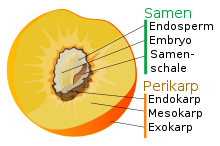Drupe
![]()
This article deals with vegetable fruits. For the medical meaning of drupe, see Lithopaedion.
Stone fruits are closed fruits in which the seeds are enclosed in a woody core. The exocarp is membranous, the mesocarp fleshy or leathery-fibrous, while the endocarp forms the woody shell of the usually single stone, which often contains one seed, but may also contain several seeds. The stone is also called pyrene or the stone shell (endocarp) is called putamen. However, it can also contain several stone seeds as in some species.
There is in most cases a connection with an adaptation to endozoochory, the seed dispersal by fruit-eating animals. The seed is protected from damage by the lignified endocarp, the inner layer of the pericarp. Around it, the outer layers of the pericarp, the mesocarp and exocarp, form fleshy, juicy parts made up of living cells. These are not always edible for humans (for example in the case of coconuts).
Stone fruits include:
- with edible pulp: mango, mirabelle, nectarine, peach, plum, damson, apricot, olive, sour cherry, sweet cherry, cornelian cherry
- with edible seed or endosperm (seed-nutmeat): coconut, almond, peach (for persipan) and pistachio
Special forms are the aggregate drupe, such as the blackberry and the raspberry, and the drupe (e.g. fig, jackfruit).
The "coccum" also forms a special form, it is formed from only one carpel and opens along two sutures, it stands between an opening drupe or capsule and a legume. Also, because the term legume refers to the fruits of the leguminous plants, a distinction is necessary. It occurs, for example, in the nutmeg family and in the silver tree family.
Very rarely there are winged drupes as in Coffea pterocarpa.

Peach as an example of a stone fruit with hard endocarp
See also
- Stone fruit
- Gathering Stone Fruit
Search within the encyclopedia